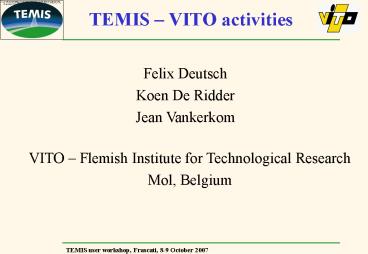TEMIS PowerPoint PPT Presentation
1 / 23
Title: TEMIS
1
TEMIS VITO activities
Felix Deutsch Koen De Ridder Jean Vankerkom
VITO Flemish Institute for Technological
Research Mol, Belgium
2
Contents
- Short overview of the BelEUROS-modelling system
- Results reached in TEMIS
- - Improvement of boundary conditions for
BelEUROS - - Contribution of LRTAP to air quality in
Belgium - Possible future contributions to TEMIS
3
Overview of the BelEUROS-modelling system
- EUROS created by RIVM (Netherlands) for
modelling of ozone - in Belgium implemented in 2001 for ozone
- in 2004/2005 BelEUROS extended by VITO with two
modules for modelling - additionally primary and secondary particulate
matter (PM10, PM2.5) - Meteo ECMWF (T, rH, wvwd, CC, PR, mixing layer
height) - Emissions EMEP/CORINAIR additionally local
emission inventories - with higher resolution, e.g.
for Belgium - Chemistry for O3, NOx Carbon Bond IV (CB-IV)
gas phase mechanism, for PM10, PM2.5
CACM aerosol module MADRID 2 - Resolution horizontal 60 km/15 km or 7.5 km
- vertical 4 layers
(chemistry), 14 layers advection
4
Overview of the BelEUROS-modelling system
5
Overview of the BelEUROS-modelling system
refined grid resolution 15 km x 15 km (or 7.5 km
x 7.5 km)
6
Overview of the BelEUROS-modelling system
7
Results reached in TEMIS
required input data
- meteorology 3-D fields of wind speed
direction, temperature, humidity, cloud cover,
precipitation, mixing height (ECMWF) - emissions per pollutant (NOx, VOCs, ) and per
sector (traffic, industry, biogenic) - but additionally
- boundary conditions concentrations of O3, NO2
and all other chemical species at the boundaries
of the model domain (up to now climatological
values) these lateral boundary values were
specified as long-term (monthly) mean
concentrations), but no actual concentrations for
a certain period
8
Results reached in TEMIS
Methodology for improved boundary conditions for
the BelEUROS-model
- Retrieval of 3-D concentration fields of all
chemical species of the CB-IV mechanism from the
TM4 model and interpolation to the lateral grid
cells of BelEUROS to replace the climatologies
9
Results Improved BC
Ozone concentrations at the Western boundary of
the BelEUROS domain simulated by TM4
10
Results Improved BC
Ozone Comparison of TM4 BC and BelEUROS
climatology
11
Results Improved BC
NO2 concentrations at the Western boundary of the
BelEUROS domain as simulated by TM4
12
Results Improved BC
TM4 Episode of transatlantic NO2-transport
13
Results Improved BC
NO2 Comparison of TM4 BC and BelEUROS climatology
14
Results Improved BC
Bias -27,1 (Clim.) -9,1 (TM4)
15
Results Improved BC
Bias -44,9 (Clim.) -24,5 (TM4)
16
Results Contribution of LRTAP
Impact of transatlantic O3 transport on European
air quality (O3)
BE 37 annual mean contribution
17
Results Contribution of LRTAP
Impact of transatlantic O3 transport on European
air quality (NO2)
BE 6.5 annual mean contribution increasing O3
background can lead to non-attainment of EU limit
value for NO2 by changing the NO/NO2-ratio!
18
Results Contribution of LRTAP
Impact of transatlantic NO2 transport on
European air quality (NO2)
19
Results TEMIS website
Impact of transatlantic NOx transport on
European air quality (O3)
20
Conclusions
- Nesting of the components of the ozone chemistry
of BelEUROS into TM4 concentration fields
resulted in more realistic representation of long
range transport of air pollutants in BelEUROS
simulations. - This improved the model performance, e.g. of
ozone simulations in winter/spring/autumn. - Calculations showed the high impact of
transatlantic O3-transport on annual mean O3- and
NO2-concentrations in Europe. Transatlantic
NO2-transport can have an impact on
NO2-concentrations during episodes. - 4) Model performance would certainly benefit from
a further improvement of boundary conditions by
using Earth Observation data, also for the fine
particulate matter species.
21
Possible future contributions to TEMIS
- Further improvement of boundary conditions for
the BelEUROS model - nesting of the fine particulate matter version of
BelEUROS into TM4 concentration fields (PM2.5,
NH4, SO42-, NO3-) - using Aerosol Optical Depth (AOD) data for
improved boundary conditions, taking LRT of fine
particulate matter into consideration - using tropospheric ozone data for improved
boundary conditions and LRT of ozone
22
Possible contributions to TEMIS II
Daily forecast of PM10 concentrations for the
Belgian Interregional Environment Agency These
forecasts only use local information and suffer
from the lack of information on long range
transport of PM10
- Improvement of PM10 forecasts using AOD
observations from satellites, especially for
taking e.g. Sahara dust, forest fires and biomass
burning into consideration
23
Possible contributions to TEMIS II
- Detection of upcoming PM clouds
- Combination of forecast model with trajectory
model and AOD data - combine AOD EO data with forecasted back
trajectories by e.g. Flextra/Flexpart - This would permit the detection of upcoming PM
clouds

